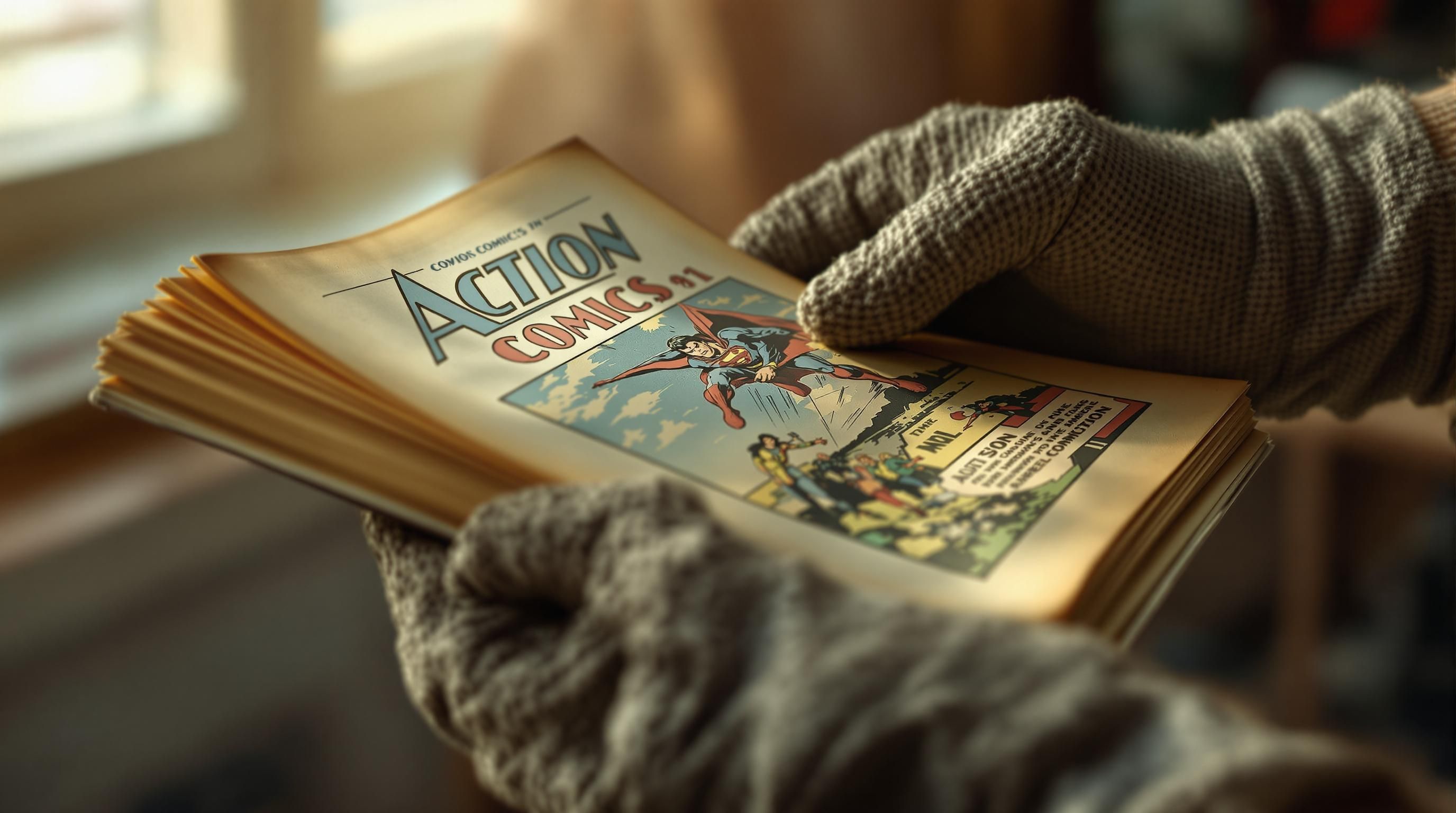Introduction to Comic Book Valuation
If you’ve ever wondered “how much are my comics worth?” you’re not alone. Comic book valuation can seem daunting, but with the right information and resources, you can accurately assess your collection’s value. This comprehensive guide will walk you through everything you need to know about determining the worth of your comic books.
Comic Book Market at a Glance
Factors That Determine Comic Book Value
Age and Rarity
Generally, older comics tend to be more valuable, especially those from the Golden Age (1938-1956) and Silver Age (1956-1970). However, age alone doesn’t determine value—rarity plays a crucial role. A comic might be old but common, or relatively new but extremely rare due to limited print runs.
Significance and Key Appearances
Comics featuring the first appearance, origin story, or death of major characters can command premium prices. For example, Amazing Fantasy #15 (first appearance of Spider-Man) or Detective Comics #27 (first appearance of Batman) are among the most valuable comics ever published.
Condition
Perhaps the most critical factor in determining a comic’s value is its condition. Comics in pristine condition are worth significantly more than those with damage or wear.
Comic Book Condition Assessment
Check applicable items to estimate your comic's condition grade
- Pages are white or off-white with no discoloration
- Cover is glossy with vibrant colors
- No creases, bends, or folds visible
- Spine is tight and undamaged
- All pages are intact with no tears
- Staples show no rust and are firmly attached
- No writing, stains, or other marks
- Original inserts (if any) are present
Professional Grading
Comics graded by professional services like CGC (Certified Guaranty Company) or CBCS (Comic Book Certification Service) often sell for higher prices than ungraded comics of similar quality. The grading scale typically ranges from 0.5 (Poor) to 10.0 (Gem Mint).
Value Impact of CGC Grading
How grading affects average market value of key comics
</tbody>
</table>
Publisher and Title
Comics from major publishers like Marvel and DC typically have more established markets and values than those from smaller publishers. However, independent comics with significant cultural impact (like early issues of The Walking Dead) can also command high prices.
Essential Tools for Comic Book Valuation
Online Price Guides
Online price guides compile data from numerous sources to provide current market values. Some of the most popular include:
- Comics Price Guide - Offers a comprehensive database with values and collection management tools
- GoCollect - Tracks values of graded comics in near real-time
- Comic Book Realm - A free resource with a large database of comic values
- Heritage Auctions Comic Value - Uses auction data for accurate valuations
- PriceCharting - Provides historical price data and trends
Mobile Apps
Mobile apps make valuation more convenient, especially when browsing comics at stores or conventions:
- CLZ Comics - Popular for tracking collections and providing ballpark values
- Key Collector Comics - Focuses on identifying key issues
- CovrPrice - Automatically tracks collection value with market updates
Auction Results
Checking recent auction results provides the most accurate picture of current market values. Major auction houses like Heritage Auctions and online platforms like eBay are excellent resources for real-world sales data.
Recent Notable Comic Book Sales
High-profile comic book auction results from 2023
| Category | Price | Notes |
|---|---|---|
| Ungraded | Base Value | Varies widely based on perceived condition |
| CGC 3.0-4.0 (Good/Very Good) | 1.5-2x Base Value | Common grade for vintage comics |
| CGC 6.0-7.0 (Fine/Very Fine) | 3-5x Base Value | Above average condition |
| CGC 9.0-9.2 (Near Mint/Near Mint-) | 8-12x Base Value | Excellent condition with minimal flaws |
| CGC 9.8-10.0 (Near Mint/Gem Mint) | 15-30x Base Value | Museum quality, extremely rare for vintage |
</tbody>
</table>
Identifying Valuable Comics in Your Collection

Key Issue Indicators
Look for these telltale signs that a comic might be valuable:
- Cover Price - Comics with cover prices of 10¢, 12¢, 15¢, 20¢, or 25¢ are from earlier eras and potentially more valuable
- First Appearances - Often noted with “1st appearance” on covers or in collector’s guides
- Issue Numbers - Early issues (#1-20) of long-running series are typically more valuable
- Special Editions - Variant covers, anniversary issues, or limited editions
- Publisher Milestones - Company debuts, transitions, or final issues
Most Valuable Comic Book Eras
Comic Book Ages and Their Value Potential
- 1938-1956
Golden Age
The birth of superhero comics including Action Comics #1 (Superman), Detective Comics #27 (Batman), and Captain America Comics #1. Comics from this era in good condition are extremely valuable. - 1956-1970
Silver Age
Renaissance of superhero comics featuring The Flash, Spider-Man, X-Men, and the Justice League. Silver Age key issues are highly sought after by collectors and investors. - 1970-1985
Bronze Age
Darker storylines and socially relevant topics emerged. First appearances from this era (like Wolverine in Hulk #181) continue to appreciate in value. - 1985-1991
Copper Age
Independent publishers flourished and landmark titles like Watchmen and The Dark Knight Returns were published. Many investment-grade comics originated in this period. - 1991-Present
Modern Age
Characterized by artistic innovation, numerous #1 issues, and variant covers. Most modern comics have limited value, but exceptions include key first appearances and low-print variants.
Focus on the “Big Keys”
While thousands of comics have some value, a relatively small number of issues are considered “big keys” – comics that have significant historical importance and consistently high values. Familiarizing yourself with these key issues can help you quickly identify potential treasures:
Top 10 Most Valuable Comic Books
Based on recent high-grade sales (9.0+ condition)
| Item | Price | Date | Auction House |
|---|---|---|---|
| Action Comics #1 (CGC 8.5) | $3,450,000 | June 2023 | Heritage Auctions |
| Amazing Fantasy #15 (CGC 9.2) | $1,250,000 | April 2023 | ComicConnect |
| Detective Comics #27 (CGC 7.0) | $1,125,000 | March 2023 | Goldin Auctions |
| X-Men #1 (CGC 9.8) | $675,000 | May 2023 | Heritage Auctions |
</tbody>
</table>
Step-by-Step Guide to Valuing Your Comics

1. Catalog Your Collection
Create an inventory of your comics, recording:
- Publisher
- Title
- Issue number
- Publication date
- Cover price
- Notable features (variant covers, writer/artist signatures)
Many collectors use apps like CLZ Comics or spreadsheets to track their collections.
2. Assess Condition
Evaluate each comic’s condition using the industry-standard 10-point scale:
Comic Book Grading Scale
Industry standard condition ratings and their characteristics
| Category | Price | Notes |
|---|---|---|
| Action Comics #1 (1938) | $3,000,000+ | First appearance of Superman |
| Detective Comics #27 (1939) | $1,500,000+ | First appearance of Batman |
| Marvel Comics #1 (1939) | $1,200,000+ | First Marvel publication |
| Amazing Fantasy #15 (1962) | $1,000,000+ | First appearance of Spider-Man |
| Batman #1 (1940) | $800,000+ | First dedicated Batman title, intro of Joker/Catwoman |
| X-Men #1 (1963) | $700,000+ | First appearance of the X-Men |
| Fantastic Four #1 (1961) | $650,000+ | First appearance of the Fantastic Four |
| Captain America Comics #1 (1941) | $600,000+ | First appearance of Captain America |
| Incredible Hulk #1 (1962) | $450,000+ | First appearance of the Hulk |
| Showcase #4 (1956) | $400,000+ | First appearance of Silver Age Flash, start of Silver Age |
</tbody>
</table>
3. Research Market Values
Use a combination of resources to determine current market values:
- Online Price Guides - Check multiple sources for consensus
- Recent eBay Sales - Filter for “sold” listings to see actual transaction prices
- Auction House Results - For high-value comics
- Comic Book Stores - Local shops may offer free appraisals
4. Consider Professional Grading
For comics potentially worth over $100, professional grading from services like CGC or CBCS might be worthwhile. Graded comics typically:
- Sell for higher prices
- Are easier to market to serious collectors
- Have authenticated condition
- Are protected in tamper-evident cases
5. Document Your Findings
Keep detailed records of your valuations, including:
- Date of valuation
- Sources used
- Estimated value range
- Notable comparable sales
This documentation is invaluable for insurance purposes or when preparing to sell.
Common Misconceptions About Comic Book Values
Myth: All Old Comics Are Valuable
While age is a factor, many old comics have little value due to poor condition, common stories, or large print runs. A mint condition modern key issue can be worth more than a common Golden Age comic in poor condition.
Myth: High Print Run Special Editions Are Investments
Many “collector’s editions” and “special issues” from the 1990s were printed in such large quantities that they never became scarce. The comic market crash of the mid-1990s was largely due to overproduction of such “collectible” issues.
Myth: Sealed Comics Are Always in Mint Condition
A comic still in its original polybag isn’t necessarily in perfect condition. Comics can be damaged during packaging or shipping, and paper can deteriorate even inside a sealed bag.
Myth: My Comics Will Always Increase in Value
Comic values fluctuate based on collector interest, media adaptations, and market conditions. While some comics appreciate significantly, others remain stagnant or decrease in value.
When to Seek Professional Appraisals
Consider Professional Appraisal If:
- You’ve identified potentially high-value comics (worth $1,000+)
- You need valuation for insurance or estate purposes
- Your collection includes pre-1960s comics in good condition
- You’re planning to sell a significant collection
- You have unusual or rare variants
Where to Find Professional Appraisers:
- Auction Houses - Heritage Auctions, ComicConnect, and others offer free appraisals for potential consignments
- Major Comic Conventions - Often feature appraisal booths or panels
- Specialized Comic Dealers - Established shops frequently offer appraisal services
- Certified Appraisers - Look for members of professional organizations like the American Society of Appraisers
Managing and Tracking Your Comic Collection's Value
Collection Management Software
Several apps and platforms specifically designed for comic collectors include:
- CLZ Comics - Comprehensive with barcode scanning and value tracking
- CovrPrice - Automatically updates values based on recent sales
- League of Comic Geeks - Free option with basic tracking features
- GoCollect - Excellent for graded comics with detailed analytics
Proper Storage for Value Preservation
How you store your comics significantly impacts their long-term value:
- Bags and Boards - Use acid-free materials
- Comic Boxes - Sturdy, acid-free storage boxes
- Environment - Store in cool, dry, dark conditions
- Handling - Use cotton gloves when handling valuable issues
- Slabs - Consider professional grading and encapsulation for key issues
Regular Reappraisal
Comic values change over time. Schedule regular reappraisals:
- Quarterly for investment-grade comics
- Annually for general collections
- After major media adaptations featuring characters from your collection
- Following significant market events
Essential Comic Book Valuation Resources
Comics Price Guide
Comprehensive online price guide with collection management tools, valuations, and community features for comic collectors.
GoCollect Comic Book Price Guide
Real-time pricing data for graded comics with market trends and analytics for serious collectors and investors.
Heritage Auctions Comic Value Guide
Access auction results and valuation resources from the world's largest comic book auctioneer with expert appraisal options.
ComicBookRealm Price Guide Database
Free comic book price guide with extensive database and community features for collectors of all levels.
Quality Comix Price Guide
Detailed guides on comic book valuation with publisher-specific resources and genre-based valuation information.
PriceCharting Comic Book Prices
Historical price tracking for comics with graded and ungraded values based on verified sales data.
CGC Comics Forums
Community discussions on comic valuation, grading, and market trends from collectors and industry professionals.
Reddit Comic Book Collecting Community
Active community of collectors discussing valuation, key issues, and collection management strategies.
Selling Your Comics: Options and Considerations
Selling Options Comparison
Comic Book Selling Options
Comparison of different selling methods
| Category | Price | Notes |
|---|---|---|
| Gem Mint (10.0) | Perfect in every way - virtually non-existent for vintage comics | 100% of guide value |
| Mint (9.9) | Nearly perfect with imperceptible flaws | 95-100% of guide value |
| Near Mint/Mint (9.8) | Almost perfect with minimal imperfections | 90-95% of guide value |
| Near Mint+ (9.6) | Excellent condition with very minor flaws | 80-90% of guide value |
| Near Mint (9.4) | Nearly perfect with slight imperfections | 70-80% of guide value |
| Very Fine/Near Mint (9.2) | Excellent appearance with minor defects | 60-70% of guide value |
| Very Fine+ (8.5) | Attractive copy with minor wear | 50-60% of guide value |
| Very Fine (8.0) | Above average with minor wear and defects | 40-50% of guide value |
| Fine/Very Fine (7.0) | Above average appearance with moderate wear | 30-40% of guide value |
| Fine (6.0) | Attractive with significant wear and minor defects | 20-30% of guide value |
| Very Good/Fine (5.0) | Slightly above average with considerable wear | 15-20% of guide value |
| Very Good (4.0) | Below average with significant wear and defects | 10-15% of guide value |
| Good/Very Good (3.0) | Heavy wear but complete and readable | 5-10% of guide value |
| Good (2.0) | Heavily worn but intact and readable | 2-5% of guide value |
| Fair/Good (1.5) | Heavily worn and possibly incomplete | 1-2% of guide value |
| Fair (1.0) | Very heavily worn, possibly missing pages | <1% of guide value |
| Poor (0.5) | Barely holding together, extreme wear/damage | <0.5% of guide value |
</tbody>
</table>
Preparing Comics for Sale
To maximize the value when selling:
- Ensure proper storage and presentation
- Provide detailed descriptions and condition notes
- Include clear, well-lit photographs
- Research comparable sales for realistic pricing
- Consider professional grading for key issues
- Be prepared to verify authenticity
Tax Implications
Be aware that selling valuable comics may have tax implications:
- Comics sold for profit may be subject to capital gains tax
- For large collections, consult a tax professional
- Keep detailed records of purchase prices and selling prices
- Professional appraisals may be needed for tax documentation
Frequently Asked Questions About Comic Book Values
Is there an app that tells you how much a comic book is worth?
Yes, several apps can help determine comic book values:
- CLZ Comics provides estimated values based on condition and recent sales
- CovrPrice automatically tracks market values and your collection worth
- Key Collector Comics focuses on identifying and valuing significant issues
- GoCollect offers detailed valuation for graded comics
While these apps provide good estimates, they should be used alongside other resources like price guides and recent auction results for more accurate valuations.
Where can I get comics valued professionally?
Professional comic book valuations are available from:
- Auction houses like Heritage Auctions or ComicConnect (often free for potential consignments)
- Certified appraisers specializing in collectibles or pop culture
- Major comic book conventions that feature appraisal booths
- Established comic book dealers with expertise in rare and valuable comics
- Professional grading services like CGC or CBCS (valuation comes with grading)
For insurance purposes, you may need a formal appraisal document from a certified appraiser rather than just an informal valuation.
How much can I sell my comics for?
The selling price of your comics depends on several factors:
- Condition is paramount; near mint comics can sell for 5-10x more than the same issue in poor condition
- Rarity and significance greatly impact value; key issues command premium prices
- Current market demand fluctuates based on media adaptations and collector interest
- Selling venue affects price; direct sales to collectors typically yield higher returns than selling to dealers
Modern comics (1980s-present) typically sell for $1-$3 each unless they contain significant first appearances or are rare variants. Vintage comics in good condition, especially from the Golden and Silver Ages, can sell for hundreds or thousands of dollars.
What are the most accurate comic book price guides?
The most reliable comic book price guides include:
- GPA (Graded Price Analysis) - Specifically for professionally graded comics
- GoCollect - Uses verified sales data with excellent historical tracking
- Heritage Auctions Archive - Records of actual high-profile auction sales
- Overstreet Price Guide - The longest-running guide, published annually
- ComicsPriceGuide.com - Frequently updated online resource
For the most accurate valuation, cross-reference multiple sources and focus on actual recent sales rather than asking prices or guide values.
Are comics from the 1990s worth anything?
Most comics from the 1990s have limited value due to massive overproduction during the speculator boom. However, exceptions include:
- First appearances of popular characters (like Deadpool in New Mutants #98)
- Early Image Comics issues (Spawn #1, Walking Dead #1)
- Certain limited series or events (Kingdom Come, Marvels)
- Low-print variants or retailer incentives
- Comics in certified 9.8-10.0 condition
While most 1990s comics sell for just $1-5, these exceptions can be worth hundreds or even thousands of dollars. The key is identifying the rare valuable issues among the vast majority with minimal value.
Does getting comics graded increase their value?
Professional grading can significantly increase a comic's value, particularly for:
- Key issues worth over $100 ungraded
- Comics in excellent condition (potential 9.0+ grade)
- Highly sought-after issues where condition authentication matters to buyers
The value increase typically outweighs grading costs (approximately $20-100 per comic plus shipping) for comics that grade 9.0 or higher. However, for common issues or comics in lower grades, professional grading may cost more than any potential value increase.
Grading provides:
- Objective condition assessment
- Protection in a sealed case
- Authentication (especially important for valuable signatures)
Easier marketability to serious collectors
What is the rarest comic book in the world?
Action Comics #1 (1938) is widely considered the rarest and most valuable mainstream comic book. It features the first appearance of Superman and launched the superhero genre. Other extremely rare comics include:
- Detective Comics #27 (1939) - First appearance of Batman
- Marvel Comics #1 (1939) - First Marvel publication
- Batman #1 (1940) - First dedicated Batman title
- Flash Comics #1 (1940) - First appearance of The Flash
Beyond mainstream publications, certain promotional comics, ashcans (test prints), and publisher prototypes are so rare that only a handful of copies exist, making them almost priceless to serious collectors. The highest price ever paid for a comic was $5.3 million for a copy of Action Comics #1 in CGC 8.5 condition.
How can I tell if my comic is a first printing?
To determine if your comic is a valuable first printing:
- Check the indicia - The small print on the first page or inside cover lists the publication information, including print run
- Look for a number line - Modern comics may have a number sequence like "1 3 5 7 9 10 8 6 4 2" where the lowest number indicates the printing
- Compare cover price - Reprints often have different prices than first printings
- Check cover indicators - Second+ printings may have different cover art, colors, or explicit "Second Printing" text
- Publication date - Compare the date to known first printing release dates
For older comics, consult reference guides like the Overstreet Guide or collector communities to identify specific first printing markers for particular issues.
Conclusion: Understanding What Your Comics Are Worth
Whether you’re a dedicated collector, inherited a collection, or simply curious about potential hidden treasures, knowing the value of your comics provides peace of mind and opens possibilities for insurance, selling, or continuing to build an investment-grade collection.
Remember that comic book values are dynamic, influenced by popular culture, collector trends, and market conditions. Regular revaluation and staying connected with the collector community will ensure you remain informed about your collection’s worth.
For the most valuable comics in your collection, professional appraisal and grading services offer the most accurate valuation and can significantly enhance marketability and value. For the rest, online resources and price guides provide good ballpark figures for understanding what your comics are worth.
Get a Professional Appraisal
Unsure about your item’s value? Our certified experts provide fast, written appraisals you can trust.
- Expert report with photos and comps
- Fast turnaround
- Fixed, upfront pricing
No obligation. Secure upload.
| Category | Price | Notes |
|---|---|---|
| Local Comic Shops | 40-60% of market value | Immediate payment, no shipping, build relationships |
| eBay/Online Marketplaces | 70-90% of market value | Larger audience, fees (10-15%), shipping required |
| Auction Houses | 70-100%+ of market value | Best for high-value comics, professional marketing, 15-25% commission |
| Direct to Collectors | 80-100% of market value | No fees, requires networking, possible security concerns |
| Comic Conventions | 60-80% of market value | Multiple buyers, immediate sales, table/admission costs |
| Online Comic Communities | 70-90% of market value | Knowledgeable buyers, possible fees, shipping required |




